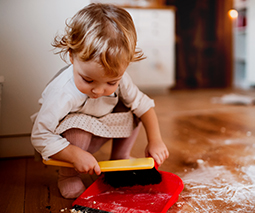Should you be using a nightlight for your kids?

Many parents swear by using nightlights for their children. However, the majority of experts say they’re unnecessary and could be creating more issues than they’re solving. So, do you use one or not? Here are all the pros and cons to help you make up your mind.
Types of nightlights
These days there are all kinds of night lights on the market to suit every little boy and girl (and their parents!). So, first of all, let’s look at a brief rundown of the different types you can get:
- Temperature monitor – This is a night light by accident, with the primary function being a thermometer, so you know what temperature the room is. Ones like the GroEgg give off a dim light with the degree displayed digitally, and it also changes colour when it’s too hot or cold.
- Baby monitor – Most baby monitors give off a faint glow or light, which can also be used as a nightlight.
- Wall plug – These are often decorative shapes, such as a star, that are attached to a short electrical plug which you put straight in the wall socket (no cord).
- Battery-operated wall mount – Instead of a plug, these are battery operated and often are decorative pieces which you mount on the wall – e.g. a glowing soccer ball or fairy.
- Sun clock – A digital clock.
- Bunting light – A string of fairy lights or lights within decorations (e.g. lantern balls) that are on an electrical cord which you strew across the room and plug into the wall.
- Light projector – A light that projects a pattern across the ceiling, such as stars. Sometimes also the projection moves in a rotating pattern.
- Bedside lamp – This might have a fun design and be fitted with a dim bulb.

The pros
Whatever the type, nightlights in children’s rooms are pretty common and have been around for a while now. Why so popular?
- They look cute – Most kids are pretty chuffed to have their favourite character in their room in light form, or something fun like a starry ceiling.
- They put kids at ease – A little bit of light can help an anxious kid who might be afraid of the dark fall asleep better, particularly if she’s in a new environment.
- They help with toilet trips – Even if your child has mastered toilet training, accidents can happen at night for a long time, and often it’s because she can’t find her way to the bathroom in the dark.
- They can have multiple functions – As per above, products such as digital thermometers, baby monitors or clocks can be useful for parents and the night light is the bonus.
- They help parents see – This is particularly useful at nighttime for mums who are breastfeeding, or when you need to check a fever or administer medication and don’t want to switch on the light.
- They help siblings who share a room – When siblings of different ages share rooms, a night light can be helpful when the older one goes to bed at a later time, allowing them to get ready for bed in low light.
The cons
Before rushing out to buy a bunch of fancy lights, there are a few things you need to be aware of:
- They mess with melatonin – This is the biggest issue. When we sleep in a room that’s not dark, it affects our ability to secrete the sleep-inducing hormone melatonin, which is necessary for making us tired. Children with night lights could find it harder to fall asleep, or they might experience a poorer quality of sleep.
- They can be distracting – Some night lights, particularly those with movement, can be very distracting for kids and prevent them from falling asleep quickly.
- They can create a fear of the dark – Babies are born without fear and will happily sleep in the dark with no dramas. It’s not until about the age of two or three, when their imagination kicks in, that they might develop a fear of the dark. However, preempting this with a night light earlier could actually bring about that fear.
- They can cause issues when away – If your child is used to having a night light on and you forget when on holiday or sleeping over with the grandparents, this could be very distressing for them.
- They can be a power drain – Anything electrical that’s on all night can be a huge drain on your power bill. And if you’re using one with batteries, it can not only be costly to replace the batteries regularly, but it’s a hassle too.

Tips and tricks
If you do decide to go ahead with putting a nightlight in your child’s bedroom, follow these tips:
- Wait until it’s needed – Only put one in the room if and when your child wants or needs one, such as a newly developed fear of the dark which is affecting her ability to sleep.
- Choose one with a red light – Apparently, red light is the only colour light that doesn’t affect the melatonin levels, white and blue are the worst. So opt for a nightlight with a dim, red glow.
- Use a hallway night light – An alternative to a nightlight in the bedroom is a hallway light, this provides a bit of indirect light to help them find the bathroom or not be in complete darkness (if the door is left open).
- Check the brightness – Don’t get one that lets off too much light. Some night lights are so bright you need your sunglasses and will keep waking your little one up. Choose one that’s very subtle, or replace the bulb if you need to.
- Opt for less distracting – Don’t buy one that you think will distract your child too much, such as those with movement or that look too exciting or scary.
- Use a dimmer – If you want to drop the nightlight altogether, try using one with a dimmer so you can gradually make the room darker over a couple of nights until it is no longer needed.
Other lighting tips
And while we’re talking about lights, remember to put all screens and bright lights away at least an hour or two before bedtime. Make playing with toys and reading books the last activities you do in the evening. Additionally, keep other lights around the house, such as in the bathroom and living room, on the lowest settings.
It’s also a good idea to make sure that any naps your child takes during the day are in a well-lit room – don’t use block out blinds or curtains. This way, she’ll produce more melatonin for the evening, and it won’t confuse her body clock.













